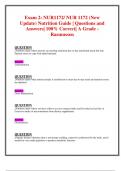Exam 2: NUR1172/ NUR 1172 (New
Update) Nutrition Guide | Questions and
Answers| 100% Correct| A Grade -
Rasmussen
QUESTION
Nutrition status where persons are meeting minimum day-to-day nutritional needs but lack
nutrient stores to cope with added demand.
Answer:
Undernutrition
QUESTION
Nutrition status when nutrient intake is insufficient to meet day-to-day needs and nutrient stores
are depleted.
Answer:
Overt Malnutrition
QUESTION
Nutrition status where you have either excessive energy intake and low physical activity or
excessive intake of macronutrients from dietary supplements.
Answer:
Overnutrition
QUESTION
Organic dietary substance that is not energy-yielding, cannot be synthesized by the body, and is
needed in very small quantities to produce metabolic function.
,Answer:
Vitamin
QUESTION
Name the 2 classes of Vitamins.
Answer:
Fat Soluble & Water Soluble
QUESTION
Vitamins A, D, E, K.
Their functions are related to structural activities with proteins.
Answer:
Fat Soluble Vitamins
QUESTION
Vitamin C and B-Complex Family (Thiamin, Riboflavin, Niacin, Pantothenic Acid, Biotin, B6.
Folate, B12). Cannot be stored except in tissue saturation. Main function is cell metabolism and
tissue building and maintenance.
Answer:
Water Soluble Vitamins
QUESTION
Natural form of Vitamin A and its synthetic copies.
Answer:
Retinoids
,QUESTION
Found in animal foods (2% Milk, Cheese, Egg yolk, Liver) and is the natural form of Vitamin
A.
Answer:
Preformed Vitamin A (Retinol)
QUESTION
Where is Preformed Vitamin A stored?
Answer:
Mostly in the liver but also in kidneys, lungs, and adipose tissues.
QUESTION
Group of yellow-red-orange pigments distributed in plants that act as antioxidants and have
other health promoting properties.
Answer:
Carotenoids
QUESTION
Carotenoids that are found in broccoli, carrots, spinach, cantaloupe, tomato juice, and apricots
which are converted to this form of vitamin A
Answer:
Provitamin A (Beta-Carotene)
QUESTION
3 Substances needed for Vitamin A absorption.
Answer:
Bile Salts, Pancreatic Lipase, Dietary Fat
, QUESTION
How is Vitamin A transported and stored?
Answer:
Enter the bloodstream via the lymphatic system and are stored in the liver or distributed to
tissues.
QUESTION
Functions of Vitamin A
Answer:
Visual Adaptation to light and darkness (Vitamin A makes Rhodopsin)
Influences integrity of body coverings and linings (epithelial tissue), cell division, growth,
immunity, reproductive function
QUESTION
How does Vitamin A Deficiency effect the eyes?
Answer:
Normal rhodopsin cannot be formed and the rods and cones become increasingly sensitive
causing night blindness.
QUESTION
How does Vitamin A deficiency effect cell differentiation?
Answer:
Keratinization occurs
Eyes-Blindness
Respiratory tract-Dryness and loss of cilia
GI tract-Dryness, poor digestion and absorption
Genitourinary tract-Vaginal and UTIs
Skin-Dry, scaly, follicular hyperkeratosis




